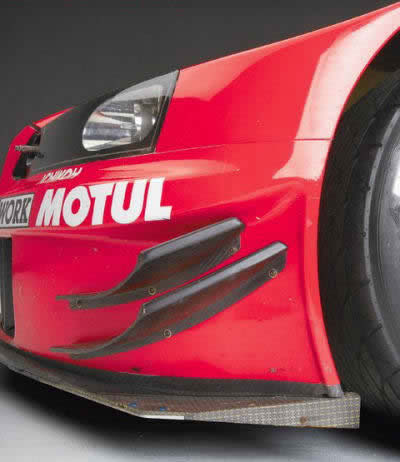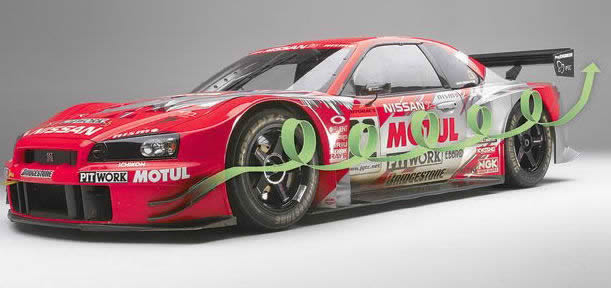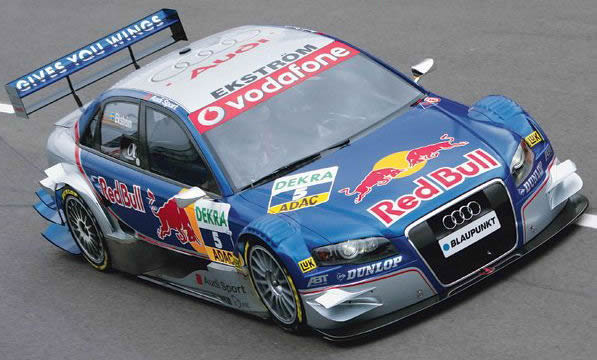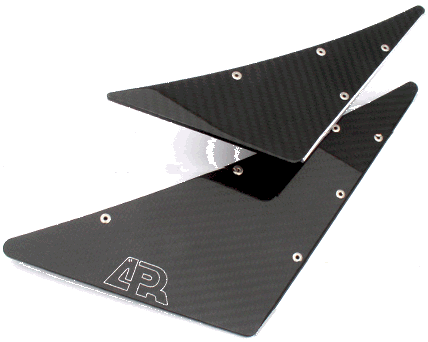Canards (Dive plates) and
vortex generators
 Also known as dive planes or dive plates, they are small triangle wings attached to the front spoiler of a car for the purposes of modifying the aerodynamic characteristics of the car in a modest way. Canards help generate downforce in two different ways. First, the canard redirects the oncoming air's momentum upwards, which causes a downward force on the canard. This is only moderate, since the velocity near the skin of the car is significantly slower than in the free stream because of boundary layer effect. Dive plates are more trimming devices than anything else, they are too small to generate large amounts of downforce; instead, they are used to fine tune the vehicle handling before a race.
Also known as dive planes or dive plates, they are small triangle wings attached to the front spoiler of a car for the purposes of modifying the aerodynamic characteristics of the car in a modest way. Canards help generate downforce in two different ways. First, the canard redirects the oncoming air's momentum upwards, which causes a downward force on the canard. This is only moderate, since the velocity near the skin of the car is significantly slower than in the free stream because of boundary layer effect. Dive plates are more trimming devices than anything else, they are too small to generate large amounts of downforce; instead, they are used to fine tune the vehicle handling before a race.

In addition, canards, together with vortex generators, generate strong vortices that travel down the sides of the car and act as a barrier. If the canards are positioned correctly, these strong vortices act in way to keep high-pressure air around the car from entering the low-pressure underbody region, thus maintaining more downforce.
If air was allowed to enter the underside, the pressure would inevitably rise, reducing downforce. Therefore, these strong vortices act like a virtual curtain or dam, restricting higher-pressure air around the car's sides from entering the underbody region.
Unfortunately, canards are not very efficient, since the strong vortices and position of canards create a significant amount of drag. They are more useful for fine-tuning aerodynamic balance. The bumper canards, once installed, provide additional small amount of downforce at the front of the vehicle, adjusting the balance of traction and thus improving the handling characteristics of the car.
Very often, front bumper canards are fitted together with vortex generators. Vortex generators are smaller triangle winglets fitted few centimeters higher of the bigger canards. Vortex generators help to guide the air flow on cars with very steep drop-off angles between the roof and the rear window. Air flow has a tendency to become turbulent as it separates from the surface of the car in this region. This turbulent air causes drag and reduces the effectiveness of a rear wing. They help to reduce drag and improve the effectiveness of the rear wing by delaying the air flow separation and reducing turbulence. In addition, vortex generators generate strong vortices that travel down the sides of the car and act as a barrier explained before, but only if positioned correctly. As a result, the low pressure under the car is maintained and downforce is maximized. However, care must be taken so that the leading edge vortices do not affect the operation of the rear wing or other aerodynamic devices.
Vortices are created when the pressure differences are created at the wing tip. As you get high pressure above the wing, low pressure beneath and near ambient pressure to the side of the endplate. When these three flows meet, the higher pressure flow naturally moves towards the low pressure areas. This sets up a tumbling motion and a spiralling flow structure is created. Use of vortices is to shape and alter flow over other areas of the car. Vortices are extremely high energy structures. But with them comes a lot of drag. These wing tip vortices rise upward and outward from the rear wing tips and eventually flatten out behind the car as their energy is dissipated in the free stream flow around the car.
The greater the pressure differential, the greater vortex is created, and this is generally seen better in damp conditions as the water in the air concentrates into the vortex to become visible as a vapour trail.
 |
Canards should be installed with the large face at the front and aligned such that they do not protrude outside the existing outer line of the car body |
In high performance racing, bumper canards and vortex generators are most likely to be installed on racing vehicles which are based on conventional road cars such as Stock Cars, Touring Cars and GT Cars where the car's essentially stock bodies (designed for road-use) have not already been designed to provide optimum aerodynamic characteristics for track use.
But they are used in Formula 1, LeMan series, DTM racing and now I am seeing them even on NASCAR cars. Basic aerodynamic principles dictate that the downforce created by air pressure on a surface increases exponentially with speed, thus, as with many aerodynamic modifications the bumper canards are best suited to the high speed of motor racing.
Due to strength and weight considerations, bumper canards designed for race use were originally fabricated from carbon fiber reinforced plastic. The high strength to weight ratio and desirable appearance of this material ensures that bumper canards currently sold for road-going cars are often also made from this material.
 Bumper canards and vortex generators are generally made either as a flat sheet 'triangles' with additional edging strips (for mounting and directing airflow) or as a bespoke molded component utilizing the strength of the material and sophisticated match tooling to integrate the necessary upturns and curvature into a single piece of carbon fiber.
Bumper canards and vortex generators are generally made either as a flat sheet 'triangles' with additional edging strips (for mounting and directing airflow) or as a bespoke molded component utilizing the strength of the material and sophisticated match tooling to integrate the necessary upturns and curvature into a single piece of carbon fiber.
Bumper canards are relatively simple to install and are often available with slightly different curvature to match the shape of the front spoiler of the vehicle to which they will be fitted. They are most commonly installed in sets of four, a larger canard and a smaller vortex generator on each side of the bumper with the larger canard at the bottom.
 |
 |
 |
Canards designed for Dodge SRT4 |
Canards designed for Dodge Viper |
Canards designed for Mitsubishi Evo |
Commercially available bumper canards include a 'mounting kit'. There is a set of high quality bolts which fasten through holes drilled in the front bumper to accommodate the canards. Canards should be installed with the large face at the front and aligned such that they do not protrude outside the existing outer line of the car body (so as to avoid creating a safety hazard). This ensures that the main area of wing surface is as far forward on the vehicle as possible in the clean air stream.
Whether bumper canards installed on road-going cars are a genuine performance enhancement or simply a cosmetic modification? How do you know if they work? How can you measure the lift they are reducing? Also is there any science behind the shape and attack angles?
First of all, on street cars traveling at legal or even near legal speeds such devices would make only a very tiny difference, if any, and if you are traveling in such a manner that this tiny difference has any effect on your ability to control the vehicle, then you should stop this practice.
The amount of down force generated is related to the speed of air passing over/under the wing. Faster speeds mean more down force. Racing vehicles that use this technology are traveling two to three times faster than any street legal vehicle should be traveling, and they are dealing in hundredths of seconds for victories worth millions of dollars.
People who are attaching these wings to street legal vehicles are either using them only for decoration, or are modifying their vehicle with the intention of using it for racing. In some rare cases they are built into the design of a street legal sports car. Of course those vehicles are designed from the start to be street legal, but fully capable of competing in races right from the factory.
Many manufacturers however are looking at the shape of the underside of their vehicles either to maximize downforce, or to minimize fuel consumption. The real racer will work on this area first before attaching tiny wings to the front of his car.
If after reading this you still want to know exactly how much downforce the canard will generate, then either the packaging should say, or the manufacturer's website should say. If they don't say, then assume it is only for decorative purposes, and will actually increase drag without improving performance.
To learn more about vortex, check my article here.
To know more about aero devices and components check this articles:
Airbox
Bernoulli equation
Canards
Diffuser
Formula 1 Engine air intake
Gourney flap
NACA duct
Side duct
Side skirts
Wings






